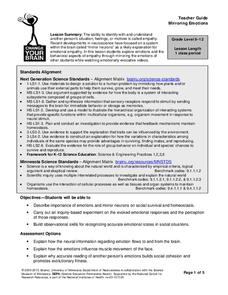Curated OER
Memory in Your World
Students rotate through three classroom stations and identify similarities and differences between machines with and without memory, such as typewriters and computers, and illustrate how machines with memory fit into their world.
Virginia Department of Education
Planet Line-Ups
Should Pluto be considered a planet or a dwarf planet? Scholars research planets in our solar system to understand their similarities and differences. It also includes memory activities related to the order of the planets.
Curated OER
Memory Book - A Cooperative Learning Experience
Students document sections of their life through pictures, stories, and video to create an English "memory book". They use photographs, video and edited video which includes their history, includes calculated growth, and genetic...
Curated OER
Roy G. Biv Has Feelings Too
Learners test their memory recall and discuss its association to color. After reading an article, they discuss the natural and psycho-sociological significance of the color red. As a class, they participate in a mood-color association...
University of Minnesota
Mirroring Emotions
Do you ever give your class the "teacher look"? Without saying a word, they become silent and engaged (hopefully). How do they know what you're thinking? Explore the concept of nonverbal communication and how it relates to our...
PBS
Stories of Painkiller Addiction: The Cycle of Addiction
Drug addiction, including prescription drug addiction, begins with a reason that's different for every user. High schoolers learn more about the reasons people begin abusing drugs with a set of videos and worksheets that discuss four...
Curated OER
Electronic Components
Students review new terminology and computer circuits and the value of a resistor. They complete three experiments, "Resistance Activities," Transistor Activities,"Diode Activities" and enter data, results and their findings on Student...
Curated OER
The Scientific Method (Senior, Science)
Student's recall from memory the steps in the scientific method. TSWBAT describe in detail the various steps of the scientific method. TSWBAT analyze a problem or situation and apply the steps of the scientific method to it.
Curated OER
Pieces of Mind: Remembering What Matters
Young scholars watch the program "Pieces of Mind" from PBS and participate in a class discussion about PET scans and their advantages. Students then brainstorm activities a PET scan could be used for.
Curated OER
Aerospace Engineering
Students explore oil field applications of Shape Memory Alloys. In this engineering lesson students divide into groups and research mini research applications then complete a project.
Curated OER
Function Junction
Students identify the internal and external components of computers, robots and fan. In this physics lesson, students draw a circuit diagram of their electronic components. They create a battery tester in the lab.
Curated OER
Motion Concentration Game
Students play a memory game that asks them to correctly match a vocabulary word about motion or force with a picture.
Curated OER
Arkansas and the Dust Bowl
Students access and use the Farm Security Administration and Office of War Information, American Memory collection and Todd and Sonkin collection for research. They develop research skills and strategies, such as key word searches to...
Curated OER
A Difference of Mind
Students discover the individual variance in brain response to its four main functions. They perform activities related to each function at four stations set up in the classroom. They discuss their responses as a class.
PBS
Stories of Painkiller Addiction: Learning About Opioids
Feeling high is not the only side effect of abusing prescription opioids. Middle and high schoolers learn more about specific painkillers, including Fentanyl, Oxycodone, and Clonazepam, as well as their common brand names and extensive...
Curated OER
Remember This?
Students investigate the mechanics of an fMRI and the properties of neurons. In this biology instructional activity, students analyze the way the brain works by performing tests in the neurons in the brain. This is all done theoretically.
Colorado State University
If You Can't Predict the Weather, How Can You Predict the Climate?
Why is the weather man wrong so often? Young climatologists discover how chaos rules both weather and climate through a math-based activity. Using an iterative equation, the class examines how small day-to-day weather events total up to...
Curated OER
The Very Hungry Caterpillar
Here is a good lesson plan on butterflies and caterpillars. After listening to The Very Hungry Caterpillar, young learners put cards that depict the life cycle of a butterfly in the correct order. There are some good ideas for center...
Curated OER
Conversions
In this measurements instructional activity, students review how metric conversions work and the prefixes associated with the conversions. Then students complete 27 problems, 1 short answer, 14 matching, and 7 fill in the blank questions.
Curated OER
Electronic Components
Students describe how resistors affect the flow of electricity. In this electronics lesson plan students examine transistors and what they do and how they work.
Curated OER
Brain-Controlled Robotic Arms: Cloze activity with Article
Fascinating content about current medical research on brain-controlled prosthetics comes in cloze activity form with a link to the original article. Useful for listening and reading comprehension skills development, and for any science...
Curated OER
Conventional Transistor Overview and Special Transistors
In this electrical circuit worksheet, students develop an understanding of micro-controllers and then answer a series of 13 open-ended questions about transistors that include analyzing schematics. This worksheet is printable and the...
Curated OER
Mind Over Matter: How Does the Brain Work
Students research previous attempts by scientists to discover the ways in which the brain works, design and conduct an experiment to illustrate current research and present their findings to the class.
Curated OER
Get to Know: Mammals
Students discover the mammals in their community. In this animal lesson, students survey their school grounds for signs of mammals. Students examine tracks, droppings, and other signs of wildlife to learn more about the animals and their...























